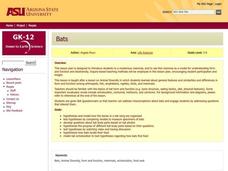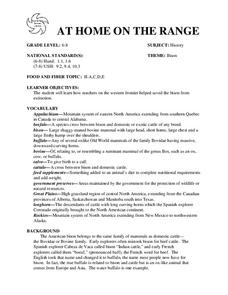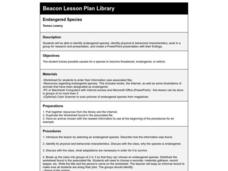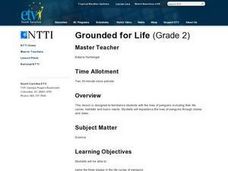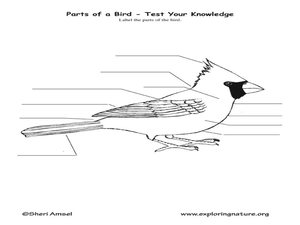Curated OER
Sharks Taxonomy
Learners, in groups, establish a classification system for the world of your classroom. They draw a chart to explain their categories and system to the rest of the class.
Curated OER
Ice Age Animals
Students research the ice age and the animals that were on the Earth at that time and have a debate on the explanation for the extinction of the ice age animals.
Curated OER
Bats
Learners model how the bones in a bat wing are organized. They develop questions about bat body parts based on photographs. They hypothesize how bats locate their food.
Curated OER
AT HOME ON THE RANGE
The student will learn how ranchers on the western frontier helped saved the bison from extinction.Hand out student worksheets. Have students read the information about bison on Student Worksheet A before completing Student Worksheet...
Curated OER
Fruits and Vegetables in the Food System
Learners examine the importance of local markets. In this horticulture lesson, students examine the importance of local markets and food systems that can provide profit for growers, freshness, variety and quality.
Curated OER
A Look At Osteoporosis
Eleventh graders study osteoporosis and understand the relationship between calcium and bone mass. For this investigative lesson students participate in an activity in which they graph and construct basic bone biology.
Curated OER
Bats
Students hypothesize and model how the bones in a bat wing are made up. In this exploratory lesson students test their hypothesis, develop questions about bat parts and watch a video on bats.
Curated OER
What Does It Eat?
Students use crickets, mealworms, and pill bugs and observe what they choose to eat. In this science lesson plan, students record data, create graphs, and do a write up on what they see happening.
Curated OER
Become an Expert
Students practice their researching techniques by preparing a presentation with little notice. In this information research lesson, students utilize the Internet to research one of several subtopics concerning panthers. Students...
Curated OER
Key to Good Health #1: Nutrition
Students learn tips for healthy eating. In this nutrition lesson, students learn about the four main food groups, view a food pyramid, and get tips on how to get the most nutrition out of their meals. Students also learning about eating...
Curated OER
When Enough Should Be Enough
Students take a closer look at world hunger. In this global issues instructional activity, students discuss hunger in African nations and determine how that might organize a school-side campaign to raise money to fight hunger through the...
Curated OER
Habitat Is Home
Pupils are introduced to the concept and components of a habitat. They discuss the key components of a habitat and describe how certain factors can cause disturbances in a habitat and change its population. Activities are leveled for...
Curated OER
What Animals Eat
First graders organize animals according to what they eat. They compare the teeth of plant eaters and meat eaters.
Curated OER
Those Amazing Seaworld Animals
Students research the animals at SeaWorld and then relate the info they have found into various types of graphs; line, circle and bar. This lesson combines math and science nicely. They access a website imbedded in this plan to do their...
Curated OER
Endangered Species
Students conduct Internet research on endangered species. They select an endangered species, identify its physical and behavioral characteristics, and create a Powerpoint presentation.
Curated OER
What Does It Eat?
Students, working in research teams, investigate the eating habits of crickets. They collect and record data and compare their methods and results with other groups by making tables or graphs. They sumarize their findings with posters or...
Curated OER
The Fish Trade
High schoolers read and discuss a document regarding how the global fish trade is important to humans all over the world. Students conduct Internet research and write a scenario about what would happen if other countries did not help...
Curated OER
Turtle Adaptations
Pupils identify structural adaptations of different types of turtles, and compare and contrast adaptations of painted turtles, sea turtles, and desert tortoises using a chart.
Curated OER
Grounded for Life
Second graders become familiar with the lives of penguins including their life cycles, habitats and basic needs. Students will experience the lives of penguins through stories and video.
Curated OER
A PRICELESS Collection
Students read a story about the life of Russian plant breeder Nikolai I and Vavilov and the national seed bank he established. They research the Irish Potato Famine of the late 1840s and identify the cause for this famine and make...
Curated OER
Parents are unawareof Ecstasy risk:Anti-drug Education
Learners read an article on parents unawareness of Ecstasy use. In this current events lesson, students infer issues related to teen drug use and parent prevention and engage in a class discussion. Learners give a quiz related to Ecstasy...
Curated OER
Learning Bird Traits
Students draw and label a bird. For this bird traits lesson, students learn what traits make a bird different from other animals. Students are taught how to draw a bird and are expected to label the various body parts they drew.




